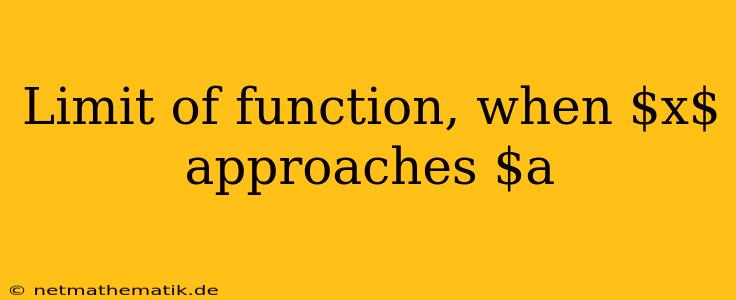The concept of a limit in calculus is fundamental to understanding the behavior of functions. It allows us to investigate what happens to a function's output as its input gets arbitrarily close to a particular value. This exploration is particularly important when dealing with points where the function might not be defined or might exhibit unusual behavior. One of the key aspects of this investigation is examining the limit of a function when x approaches a, denoted as lim x→a f(x). This article will delve into the intricacies of this concept, explaining its significance, providing various examples, and exploring different scenarios.
Understanding the Limit of a Function
The limit of a function, when x approaches a, describes the value that the function's output gets closer and closer to as the input x gets closer and closer to a, without actually reaching a.
Let's break it down:
- "Limit": It refers to the value that the function approaches.
- "When x approaches a": This signifies that the input x gets infinitely close to the value a.
- "f(x)": This represents the function we are analyzing.
Key Points:
- The limit of a function doesn't necessarily have to be the value of the function at x = a. The function might not even be defined at x = a.
- The limit is about what happens to the function near the point x = a, not at the point itself.
- The limit describes a trend in the function's output as the input gets closer to a.
Visualizing the Limit
To visualize the concept, let's consider the function f(x) = x² and examine its limit as x approaches 2:
limx→2 x²
As x gets closer to 2 from both sides (both smaller and larger values), the output of the function, f(x), gets closer and closer to 4.
!
In this example, the limit is equal to 4, even though the function is defined at x = 2 and has a value of 4.
Types of Limits
- One-Sided Limits: These examine the behavior of the function as x approaches a from either the left or the right side.
- Left-hand limit: lim x→a⁻ f(x)
- Right-hand limit: lim x→a⁺ f(x)
- Two-Sided Limits: These examine the behavior of the function as x approaches a from both sides simultaneously.
- lim x→a f(x)
Important Note: For a two-sided limit to exist, both the left-hand and right-hand limits must exist and be equal.
Calculating Limits
- Direct Substitution: If the function is continuous at x = a, we can simply substitute a into the function to find the limit.
- Algebraic Manipulation: Sometimes, we need to manipulate the function algebraically to eliminate any discontinuities or simplify the expression.
- Factoring and Cancellation: If the function has a common factor in the numerator and denominator, we can cancel it to eliminate any undefined points.
- Rationalization: If the function involves radicals, we can rationalize the denominator to simplify the expression.
- L'Hopital's Rule: If the function has an indeterminate form (0/0 or ∞/∞), we can use L'Hopital's rule to calculate the limit by taking the derivatives of the numerator and denominator.
Examples of Limits
Here are some examples illustrating various scenarios involving limits:
Example 1:
Find limx→2 (x² + 3x - 5)
Since the function is continuous at x = 2, we can use direct substitution:
limx→2 (x² + 3x - 5) = (2² + 3(2) - 5) = 7
Example 2:
Find limx→1 (x - 1)/(x² - 1)
We notice that the function is undefined at x = 1. However, we can factor the denominator and cancel the common factor:
limx→1 (x - 1)/(x² - 1) = limx→1 (x - 1)/((x - 1)(x + 1)) = limx→1 1/(x + 1) = 1/(1 + 1) = 1/2
Example 3:
Find limx→0 sin(x)/x
This is a classic example of an indeterminate form (0/0). Using L'Hopital's rule, we take the derivatives of the numerator and denominator:
limx→0 sin(x)/x = limx→0 cos(x)/1 = cos(0)/1 = 1
Importance of Limits
The concept of limits is fundamental in calculus and its applications for several reasons:
- Continuity: Limits help define the concept of continuity of functions, which is essential for many mathematical operations.
- Derivatives: Limits form the foundation for defining derivatives, which represent the instantaneous rate of change of a function.
- Integrals: Limits are also crucial in defining integrals, which represent the area under a curve.
- Real-World Applications: Limits have applications in various fields, including physics, engineering, economics, and more. For example, they help in understanding the behavior of physical systems, optimizing processes, and analyzing data.
Conclusion
The limit of a function when x approaches a is a powerful concept in calculus. It helps us understand the behavior of functions near points of discontinuity, evaluate the function's output as the input gets arbitrarily close to a specific value, and form the foundation for other important concepts in calculus. By understanding and applying the various methods for calculating limits, we gain valuable insights into the behavior of functions and their applications in real-world problems.
